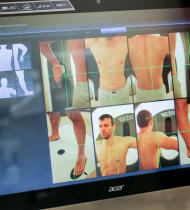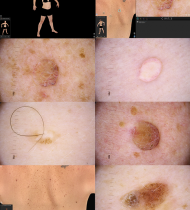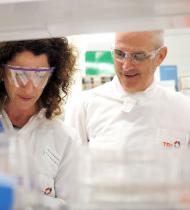Professor Soyer Peter
MD, FACD, FAHMS,
Chair in Dermatology, Director of Dermatology Research Centre, Frazer Institute, UQ
Research Themes

Projects
Centre of Research Excellence in Skin Imaging and Precision Diagnosis
(2021–2026) NHMRC Centres of Research Excellence
Naevus Surveillance using Total Boby Photography and Dermoscopy
Actinic Keratosis Surveillance Feasibility Study
About me
Professor Soyer is an academic dermatologist with over 30 years experience in the field. He was appointed as the inaugural Chair in Dermatology by The University of Queensland (UQ) in 2007 and as Director of the Princess Alexandra Hospital (PAH) Dermatology Department in 2008. He has a strong focus on translational skin cancer research in his dual role as Director of the Dermatology Research Centre (DRC), UQ Diamantina Institute, UQ Faculty of Medicine; and leadership of the Dermatology Department at the Princess Alexandra Hospital in Brisbane.
Professor Soyer is internationally recognised in the field of dermatology with particular expertise in the areas of clinical dermatology, dermatooncology, dermatopathology and dermatologic imaging (dermoscopy and reflectance confocal microscopy). Within the dermatology discipline he is a pioneer and world leader in the field of dermoscopy of pigmented skin lesions, a non-invasive diagnostic method. He has lead the development of the morphologic classification system currently used worldwide.
One of his research focuses is to expand the concept and applications of teledermatology and teledermoscopy, and he is CIE in the Centre of Research Excellence (CRE) in Telehealth. He was awarded a CRE for the Study of Naevi (2016-2020), to further investigate why some moles turn into deadly cancers and others don't, with the aim of improving our understanding of naevus development and transformation, along with recognition of the associated changes, to better prevent, predict and detect skin cancer and melanoma.
Professor Soyer has an extensive publication record with over 600 publications to date, with more than 650 citations per year (in the last 5 years) and an h-index of 70 (Google Scholar). His text book entitled "Dermoscopy - The Essentials 2nd Edition", co-authored with G Argenziano, R Hofmann-Wellenhof and I Zalaudek, has now been translated into 4 different languages (Russian, Chinese, Polish and Portuguese) and is considered a world-leading text book in the field.
Professor Soyer was awarded a Medical Research Future Fund (MRFF) Next Generation Clinical Researchers Program Practitioner Fellowship (2018-2022) and was previously a recipient of an NHMRC Practitioner Fellowship (2012-2016). Since his appointment with UQ he has been awarded 2 NHMRC Centre of Research Excellence Grants (CIA, CIE), 4 NHMRC Project Grants (CIA, CIA, CIB, CID), 1 NHMRC Partnership Grant (CIB), 2 ARC Discovery Project Grants (CIB, CID), and a Queensland Genomic Health Alliance (QGHA) Demonstration Project Grant (CIA), with many additional projects funded through other competitive, industry and philanthropic funding sources. More recently, he was awarded the Australian Cancer Research Foundation (ACRF) Australian Centre of Excellence in Melanoma Imaging and Diagnosis (ACEMID) through a $9.9M infrastructure grant. In total, through his involvement as an investigator, he has achieved over $24M in research funding for UQ.
Publications
Publications (5 selected publications)
-
Informing a position statement on the use of artificial intelligence in dermatology in Australia.
Caffery LJ, Janda M, Miller R, Abbott LM, Arnold C, Caccetta T, Guitera P, Shumack S, Fernández-Peñas P, Mar V, Soyer HP.Australas J Dermatol. 2023 Feb;64(1):e11-e20. doi: 10.1111/ajd.13946. Epub 2022 Nov 15.PMID: 36380357 Review.
-
The impact of climate change on skin health.
Anderson A, Bruce F, Soyer HP, Williams C, Saunderson RB.Med J Aust. 2023 May 15;218(9):388-390. doi: 10.5694/mja2.51931. Epub 2023 Apr 17.
-
Informing a position statement on the use of artificial intelligence in dermatology in Australia.
Caffery LJ, Janda M, Miller R, Abbott LM, Arnold C, Caccetta T, Guitera P, Shumack S, Fernández-Peñas P, Mar V, Soyer HP.Australas J Dermatol. 2023 Feb;64(1):e11-e20. doi: 10.1111/ajd.13946. Epub 2022 Nov 15.
-
Training and Retaining Physician‒Scientists in Dermatology: Australia.
Khosrotehrani K, Murrell D, Veysey E, Tong P, Bennett H, Mar V, Soyer HP.JID Innov. 2021 Nov 24;2(1):100074. doi: 10.1016/j.xjidi.2021.100074. eCollection 2022 Jan.
-
The Future of Precision Prevention for Advanced Melanoma.
Lee KJ, Betz-Stablein B, Stark MS, Janda M, McInerney-Leo AM, Caffery LJ, Gillespie N, Yanes T, Soyer HP.Front Med (Lausanne). 2022 Jan 17;8:818096. doi: 10.3389/fmed.2021.818096. eCollection 2021.











.jpg?itok=s9qzRXtK)









